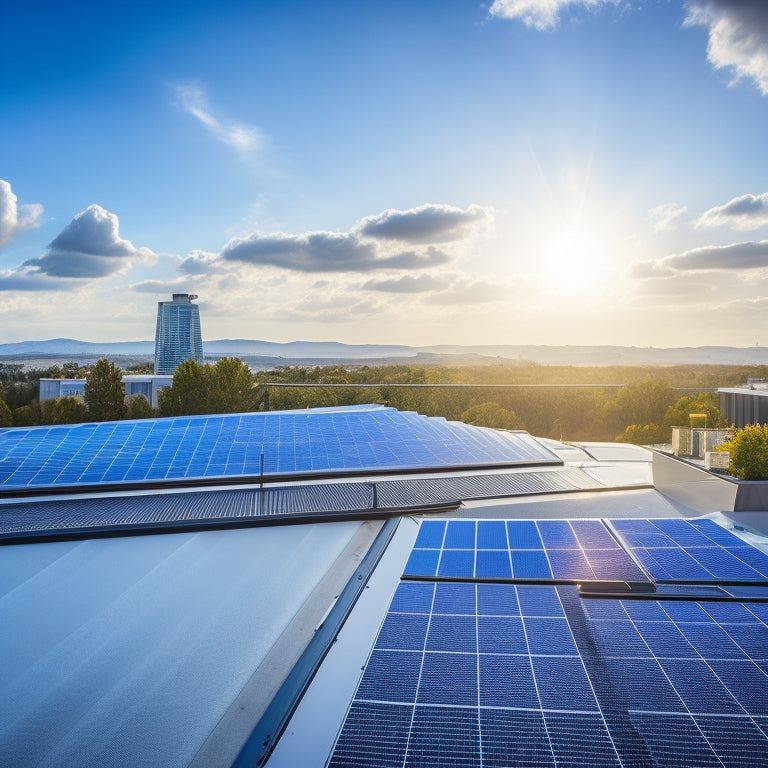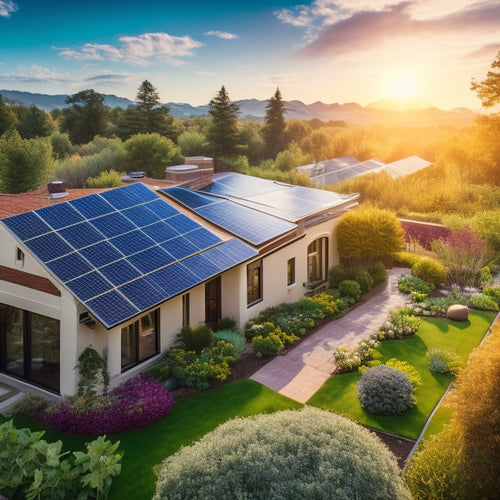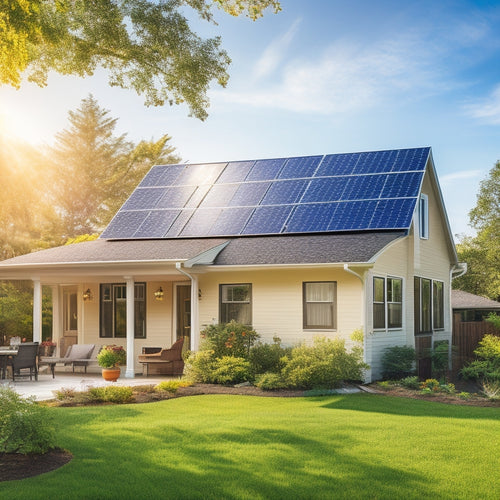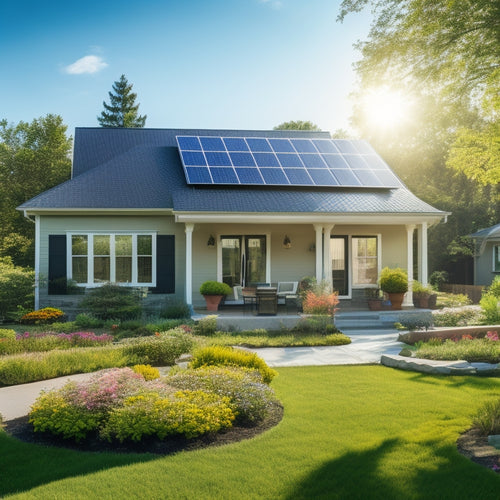
Best Solar Roof Panels for Efficient Energy Harvesting
Share
You're considering solar roof panels for efficient energy harvesting, and the good news is that top brands like Tesla, SunPower, and Panasonic offer high-efficiency panels with sleek designs and warranties of up to 25 years. When selecting the best panels for your needs, consider factors like warranty duration, customer support, certifications, and durability. Monocrystalline and polycrystalline panels vary in efficiency and cost, while thin-film solar panels provide a more affordable option. Additionally, building-integrated photovoltaics and energy conversion methods like bifacial solar cells can further optimize energy output. As you evaluate your options, you'll find that the right combination of technology and features can greatly impact your energy savings and overall return on investment.
Key Takeaways
- Tesla, SunPower, and Panasonic are top solar roof panel brands offering high-efficiency and durable products.
- Monocrystalline panels outperform polycrystalline in energy conversion, but are more expensive and ideal for smaller roofs.
- Thin film solar panels are affordable, lightweight, and flexible, making them suitable for roofs with weight restrictions or complex shapes.
- High-efficiency conversion, durability, and weather resistance are critical factors for maximizing energy savings and return on investment.
- Considerations for selecting the best solar roof panels include warranty duration, customer support, certifications, reputation, and durability.
Top Solar Roof Panel Brands
When it comes to solar roof panels, one essential consideration is the brand behind the product. You want a manufacturer that can deliver high-quality panels that meet your energy needs.
Top brands like Tesla, SunPower, and Panasonic offer premium products with superior performance and durability.
In brand comparisons, Tesla's solar roof tiles stand out for their sleek design and integrated solar cells. SunPower's X-Series panels boast an impressive 22.8% efficiency rate, making them ideal for maximizing energy production. Panasonic's HIT-240 panels offer high-efficiency rates and a 25-year warranty.
Other notable brands include Trina, Jinko, and Canadian Solar, which offer more affordable options without compromising on quality.
When selecting a brand, consider factors like warranty duration, customer support, and certifications like UL and IEC. Additionally, look for brands with a strong reputation, high-efficiency rates, and durable products.
Factors to Consider for Efficiency
As you've narrowed down your search to a reputable brand, it's time to focus on the factors that will enhance your solar roof panel system's efficiency.
Panel orientation is vital, as it directly affects the amount of energy your system can capture. Ideally, your panels should face south (in the northern hemisphere) and be tilted at an angle between 30-40 degrees to capture the most sunlight.
Shading effects can greatly reduce your system's efficiency, so it's important to assess your roof's shading conditions. Consider factors like tree coverage, neighboring buildings, and roof features that may cast shadows on your panels.
You'll also want to evaluate the temperature coefficient of your panels, as high temperatures can decrease efficiency. Additionally, look for panels with high fill factors, which indicate efficient energy conversion.
Monocrystalline Vs Polycrystalline Panels
You're likely wondering which type of solar panel is best for your roof: monocrystalline or polycrystalline.
When comparing these two options, you'll want to evaluate their efficiency ratings, as monocrystalline panels tend to outperform polycrystalline ones in this regard.
However, the cost difference between the two may tip the scales in favor of polycrystalline panels, depending on your budget and energy needs.
Efficiency Comparison
How do solar roof panels convert sunlight into electricity with varying levels of efficiency? You're likely considering monocrystalline and polycrystalline panels for your energy harvesting needs. Let's explore their efficiency comparison.
Monocrystalline panels boast higher energy conversion efficiency, typically ranging from 15% to 20%. This superior efficiency is due to their single-crystal silicon structure, allowing for more effective electron flow.
They're ideal for smaller rooftops or areas with limited space, as they can generate more power per hour of sunlight.
Polycrystalline panels, on the other hand, have lower energy conversion efficiency, typically ranging from 12% to 15%. Their multi-crystal silicon structure leads to slightly reduced electron flow, resulting in lower efficiency.
However, they're still a viable option for larger rooftops or areas with ample space, as they're often more affordable.
When evaluating solar panel ratings, look for the efficiency percentage – the higher, the better. While monocrystalline panels edge out polycrystalline ones regarding efficiency, both options can provide reliable energy harvesting.
Consider your specific needs and constraints to make an informed decision.
Cost Difference
When evaluating solar roof panels, efficiency is only half the equation - cost is the other critical factor. You need to reflect on your budget and the return on investment to make an informed decision. The cost difference between monocrystalline and polycrystalline panels can be significant.
Monocrystalline panels are more expensive due to the higher production cost of pure silicon crystals. On the other hand, polycrystalline panels are more affordable since they're made from melted silicon fragments.
Here's a breakdown of the cost difference:
-
Higher upfront cost: Monocrystalline panels can cost up to 20% more than polycrystalline panels.
-
Price trends: The cost of solar panels has been decreasing over the years, making them more accessible to homeowners. However, monocrystalline panels tend to hold their value better than polycrystalline ones.
-
Financing options: Many solar panel manufacturers and installers offer financing options or power purchase agreements to help you spread the cost over time, making high-efficiency monocrystalline panels more affordable.
Understanding the cost difference between monocrystalline and polycrystalline panels will help you make a more informed decision about which option is best for your energy needs and budget.
Thin Film Solar Panels Benefits
Thin film solar panels offer several advantages over traditional crystalline silicon solar panels, primarily due to their reduced material requirements and unique manufacturing process.
You'll benefit from lower production costs, which translates to a more affordable option for you. Additionally, thin film panels are lighter and more flexible, making them ideal for roofs with weight restrictions or complex geometries.
The advantages of thin film solar panels also extend to their energy harvesting capabilities. They perform better in low-light conditions and high-temperature environments, making them suitable for a broader range of applications.
You can install them on rooftops, building facades, or even integrate them into windows. The applications of thin film solar panels are vast, from powering residential homes to commercial buildings and even wearable technology.
Building Integrated Photovoltaics Design
As you examine the possibilities of integrating solar panels into your building's design, you'll want to contemplate Building Integrated Photovoltaics (BIPV) design. This approach combines solar panels with building envelope components, such as roofs, walls, and windows, to create a seamless and energy-efficient system.
BIPV design offers a unique opportunity to merge solar aesthetics with integrated designs, enhancing the overall structural appeal of your building.
When incorporating BIPV design into your project, consider the following key aspects:
-
Solar Facades: BIPV systems can be integrated into building facades, providing both energy generation and thermal insulation.
-
Roofing Systems: Solar panels can be designed to serve as roofing materials, replacing traditional roofing materials while generating electricity.
-
Building-Integrated Photovoltaic Windows: BIPV windows can generate electricity while still allowing light to pass through, making them an attractive option for building envelopes.
Energy Output and Durability
You're looking for solar roof panels that can maximize energy output while withstanding the elements.
High-efficiency energy conversion is essential, as it directly impacts the amount of power your system generates.
The durability of your panels is also vital, as it affects their performance over time and ultimately determines their lifespan.
High-Efficiency Energy Conversion
High-efficiency energy conversion is a critical factor in selecting the best solar roof panels, as it directly impacts your energy savings and return on investment.
When it comes to utilizing the power of the sun, you want to guarantee that your solar roof panels can convert sunlight into usable energy with maximum efficiency. This is where advanced solar cell technology comes into play.
To achieve high-efficiency energy conversion, look for solar roof panels that employ state-of-the-art energy conversion methods. These may include:
-
Bifacial solar cells: These cells can absorb light from both the front and back sides of the panel, increasing energy output by up to 25%.
-
Perovskite solar cells: These cells have shown higher power conversion efficiency rates than traditional silicon-based cells.
-
Multi-junction solar cells: These cells can capture a wider range of sunlight, resulting in higher energy conversion rates.
Long-Lasting Panel Performance
Twenty-five years or more of reliable performance is what you can expect from top-tier solar roof panels, and it's crucial to prioritize long-lasting panel performance when making your selection.
A longer panel lifespan directly translates to increased energy output over time, making it a critical factor in your investment's overall return.
Performance degradation, the gradual decline in energy output, is a natural process that occurs in all solar panels. However, high-quality panels are designed to minimize this degradation, guaranteeing you get the most out of your system.
Look for panels with low degradation rates, typically around 0.5% per year or less, to maximize your energy harvesting capabilities.
When evaluating solar roof panels, consider the manufacturer's warranty and performance guarantees.
Reputable brands will often provide 25-year or longer warranties, covering both product and performance. This assures you're protected in case your panels don't meet the expected energy output standards.
Cost-Effective Solar Roof Options
Investigate cost-effective solar roof options to make use of the power of the sun without breaking the bank. You want to tap into the energy of the sun without draining your wallet.
Fortunately, there are affordable solutions available that can help you achieve your goal.
When it comes to cost-effective solar roof options, consider the following:
-
Thin-Film Solar Panels: These panels are lighter, flexible, and cheaper to manufacture than traditional crystalline silicon panels. They're perfect for roofs with limited space or weight constraints.
-
Bifacial Solar Panels: These panels can generate electricity from both the front and back sides, increasing energy output by up to 25%. They're ideal for roofs with white or light-colored surfaces that can reflect sunlight.
-
Used or Refurbished Solar Panels: Consider purchasing used or refurbished solar panels that are still in good condition. This option can greatly reduce your upfront costs and provide an affordable installation.
Installation and Maintenance Tips
Now that you've chosen the right cost-effective solar roof option, it's time to guarantee a successful installation and maintenance routine. To overcome installation challenges, verify your roof is structurally sound and clear of debris.
Hire a certified installer who can assess your roof's condition and enhance panel placement for maximum energy collection. During installation, they'll secure the panels to your roof using a waterproofing system, connecting them to an inverter that converts DC power to AC for your home's electrical grid.
After installation, maintenance frequency is vital to guarantee peak performance. Schedule regular inspections every six months to clean the panels, inspect connections, and check for signs of wear or damage. This proactive approach will help maintain your system's efficiency, extend its lifespan, and maximize your energy savings.
Additionally, keep track of your system's performance using monitoring software to identify any issues promptly. By following these installation and maintenance tips, you'll be able to utilize the full potential of your solar roof panels and enjoy a reliable source of renewable energy.
Future of Solar Roof Technology
The solar roof industry is ready for significant advancements in the coming years, driven by ongoing research and development in photovoltaic technology. As you consider integrating solar roof panels into your energy collection strategy, it's crucial to stay informed about the emerging technologies that will shape the industry's future.
You can expect to see significant improvements in solar roof technology, including:
-
Thin-film solar cells: These innovative materials will increase energy conversion efficiency while reducing production costs.
-
Bifacial solar panels: Capable of capturing energy from both sides, these panels will enhance overall energy output and reduce installation costs.
-
Perovskite solar cells: This emerging technology promises higher power conversion efficiency, lower production costs, and improved durability.
These advancements won't only increase the efficiency of solar roof panels but also make them more affordable and accessible to a broader audience.
As the industry continues to evolve, you can expect solar roof technology to become an increasingly important part of your energy collection strategy.
Frequently Asked Questions
Can Solar Roof Panels Be Used on Metal Roofs?
You can install solar roof panels on metal roofs, but you'll need to evaluate specialized mounting options that accommodate metal's unique properties, and guarantee proper insulation considerations to maximize energy efficiency and minimize heat gain.
How Do Solar Panels Perform in Extreme Weather Conditions?
You're about to put your solar panels through a gauntlet of extreme weather, but they're built to be the "rock" that withstands the tempest. High-quality solar panels are designed to deliver consistent performance, even in scorching heat, freezing cold, and torrential rains, thanks to their exceptional durability.
Can I Install Solar Roof Panels Myself?
You can attempt a DIY installation, but be aware that it's essential to prioritize safety considerations, as improper mounting and electrical connections can be hazardous, so it's recommended to hire a professional for a secure and efficient setup.
Do Solar Roof Panels Void My Roof Warranty?
When you're considering solar roof panels, a dark cloud looms: do they void your roof warranty? You'll breathe a sigh of relief knowing that, typically, they don't, as long as you follow installation guidelines and understand warranty implications.
Are Solar Roof Panels Compatible With All Roof Types?
You'll find that solar roof panels are compatible with most roof types, considering factors like solar panel materials and roof pitch considerations; however, you'll need to verify your roof's structural integrity and angle can support the added weight and ideal energy harvesting.
Conclusion
As you weigh your solar roof panel options, remember that utilizing efficient energy harvesting is just the beginning - it's also about embracing a sustainable future. On one hand, you'll be reducing your carbon footprint and reliance on fossil fuels. On the other hand, you'll be investing in a technology that's rapidly advancing, with new innovations promising even greater efficiency and affordability. The question isn't whether to go solar, but when - and with the right panels, you'll be illuminating the way forward.
Related Posts
-

Sustainable Solar Energy for Cost-Effective Living
Adopting sustainable solar energy isn't just eco-friendly; it's a smart financial strategy. You'll slash your monthly...
-

How to Finance Home Solar Panels
Financing home solar panels offers several strategies to lighten your initial costs while maximizing long-term benefi...
-

Affordable Solar Panels for Home Use
Affordable solar panels offer you a smart way to cut down on energy costs while promoting sustainability. With govern...


